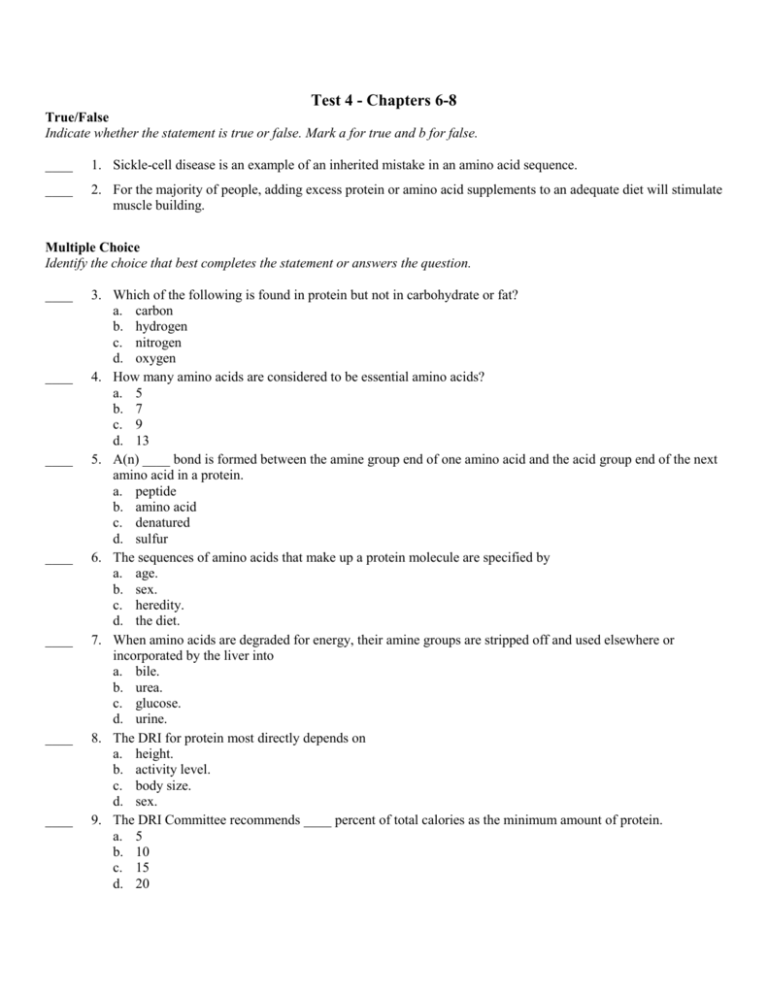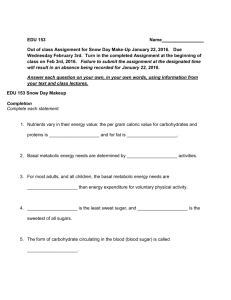Test 4 - Bakersfield College
advertisement

Test 4 - Chapters 6-8 True/False Indicate whether the statement is true or false. Mark a for true and b for false. ____ 1. Sickle-cell disease is an example of an inherited mistake in an amino acid sequence. ____ 2. For the majority of people, adding excess protein or amino acid supplements to an adequate diet will stimulate muscle building. Multiple Choice Identify the choice that best completes the statement or answers the question. ____ ____ ____ ____ ____ ____ ____ 3. Which of the following is found in protein but not in carbohydrate or fat? a. carbon b. hydrogen c. nitrogen d. oxygen 4. How many amino acids are considered to be essential amino acids? a. 5 b. 7 c. 9 d. 13 5. A(n) ____ bond is formed between the amine group end of one amino acid and the acid group end of the next amino acid in a protein. a. peptide b. amino acid c. denatured d. sulfur 6. The sequences of amino acids that make up a protein molecule are specified by a. age. b. sex. c. heredity. d. the diet. 7. When amino acids are degraded for energy, their amine groups are stripped off and used elsewhere or incorporated by the liver into a. bile. b. urea. c. glucose. d. urine. 8. The DRI for protein most directly depends on a. height. b. activity level. c. body size. d. sex. 9. The DRI Committee recommends ____ percent of total calories as the minimum amount of protein. a. 5 b. 10 c. 15 d. 20 ____ 10. The DRI for protein for healthy adults is ____ grams per kilogram of body weight. a. 0.5 b. 0.8 c. 1.0 d. 1.5 ____ 11. The calorie-deficiency disease is known most specifically as a. protein-calorie malnutrition. b. kwashiorkor. c. marasmus. d. protein-energy malnutrition. ____ 12. The more animal protein you eat, the higher your intake of ____. a. vitamin B12 b. vitamin A c. folate d. vitamin C ____ 13. Which of the following food groups does not provide significant protein? a. fruits b. grains c. vegetables d. milk, yogurt and cheese ____ 14. An athlete consumes large amounts of meat in an effort to build extra muscle tissue. This practice does not work because a. the body has no place to store extra amino acids. b. the body will dismantle its tissue proteins in this situation. c. the body converts amino acid residues to fuel or stores them as fat. d. a and c 15. What is the DRI for protein for a 40-year-old male who is 6'4" tall and weighs 180 pounds? a. 34 grams b. 49 grams c. 65 grams d. 144 grams ____ 16. The roles of enzymes formed by body proteins are important when foods are eaten because a. each enzyme has one specific chemical reaction it is responsible for. b. an enzyme acts as a catalyst to speed up a reaction without being altered itself. c. enzymes signal certain organs to respond to a change in conditions in the body. d. some enzymes can become chemical messengers in the nervous system. ____ 17. A 3-year-old child from a homeless family has been brought into the health clinic with a swollen belly, fluid buildup around her ankles, brittle hair, and irritability. Her mother has been feeding her mostly bread and dry cereal over the past several months. Providers suspect that she may have which form of PEM? a. kwashiorkor b. marasmus c. dysentery d. osteoporosis ____ 18. Compared to meat eaters, vegetarians tend to have a. higher death rates from heart disease. b. healthier body weights. c. lower blood pressure. d. a and b e. b and c ____ 19. By definition, a vitamin is all of the following except a. an organic compound. b. indispensable to body function. c. needed in minute amounts. d. a non-essential nutrient. ____ 20. A compound in food that can be converted into an active vitamin inside the body is known as a(n) a. precursor. b. antivitamin. c. coenzyme. d. enzyme. ____ 21. Any disease that produces ____ malabsorption can bring about deficiencies of vitamins A, D, E, and K. a. carbohydrate b. protein c. fat d. a and b 22. The B vitamins act as part of a. anticoagulants. b. antibodies. c. coenzymes. d. intrinsic factors. ____ 23. Which of the following B vitamins is especially important for women of childbearing age to prevent neural tube defects? a. vitamin B6 b. biotin c. folate d. vitamin B12 ____ 24. An uninformed strict vegetarian is at special risk for ____ deficiency. a. vitamin B12 b. folate c. vitamin B6 d. niacin ____ 25. Which of the following is not one of the functions of vitamin C? a. protects against infections b. produces and maintains collagen c. promotes the absorption of iron d. maintains bone density ____ 26. All of the following are good food sources of vitamin C except a. citrus fruits. b. strawberries. c. milk. d. broccoli. ____ 27. Much of the vitamin E people consume comes from a. vegetable oils and products made from them. b. fruits and vegetables. c. meats, fish, poultry, and eggs. d. a and b ____ ____ ____ ____ ____ ____ ____ 28. Who would be at the greatest risk of developing osteomalacia? a. women with low calcium intake and little exposure to the sun who have repeated pregnancies b. children breastfed for an exceptionally long time c. children with little exposure to the sun d. men with low calcium intakes 29. If someone did not meet the recommended intakes for the fat-soluble vitamins one day, you would tell him to a. increase his consumption of foods rich in fat-soluble vitamins. b. supplement his diet with a vitamin-mineral supplement. c. not be concerned as long as the diet as a whole provides average amounts that approximate the recommended intakes. d. try to consume more fats and oils to get the needed nutrients. 30. Which of the following people would be able to make sufficient amounts of vitamin D without having to eat foods containing the vitamin? a. someone who goes to a tanning booth twice a week b. someone who works in an office with windows across an entire wall c. someone who wears light-weight clothing and regularly takes a walk outdoors d. someone with dark skin who takes a 15-minute walk each day 31. Vitamin toxicity is more of a concern with which type of vitamins? a. fat-soluble vitamins because they are stored more readily in body tissues b. water-soluble vitamins because they are readily absorbed and circulate in the blood c. water-soluble vitamins because they are the main type found in vitamin supplements d. fat-soluble vitamins because they are found in higher amounts in foods 32. As a reaction to the increasing rate of the birth of children with neural tube defects in the U.S., the FDA instituted a new fortification program for all grain and cereal products in conjunction with public health programs. Which vitamin was added to these foods? a. vitamin A b. vitamin E c. folate d. vitamin B6 33. A woman who is on a low-carbohydrate diet for weight loss may have difficulty maintaining an adequate level of the B vitamins thiamin, riboflavin, niacin, and folate. What foods being avoided in her diet are most likely to cause this? a. grain foods and cereals b. fruits c. dairy products d. starchy vegetables 34. Antioxidant nutrients that actively scavenge and quench free radicals in the body include a. vitamin E. b. riboflavin. c. vitamin C. d. a and b e. a and c 35. Populations with high intakes of vegetables and fruits rich in antioxidant nutrients have low rates of a. cancer. b. lung disease. c. rickets. d. osteoporosis. ____ 36. The USP symbol on the label of a vitamin supplement means that a. it contains the ingredients as listed on the label. b. it has been tested for effectiveness. c. it will dissolve in the digestive tract. d. a and b e. a and c ____ 37. Which of the following makes up about 60 percent of the body's weight? a. major minerals b. protein c. water d. trace minerals ____ 38. The first sign of dehydration is a. headache. b. confusion. c. thirst. d. fatigue. ____ 39. Which of the following is the most abundant mineral in the body? a. calcium b. phosphorus c. sodium d. iron ____ 40. The best way to obtain the calcium you need is to a. consume more spinach, rhubarb, and Swiss chard. b. eat more cottage cheese and frozen yogurt. c. consume more milk, cheese, and yogurt. d. consume more cream cheese, butter, and cream. ____ 41. The more processed a food a. the more sodium it contains. b. the less potassium it contains. c. the less sodium it contains. d. a and b e. b and c ____ 42. Which of the following agencies is responsible for ensuring that public water systems meet minimum standards for protection of public health? a. Food and Drug Administration b. Environmental Protection Agency c. Food Safety and Inspection Service d. World Health Organization ____ 43. Which of the following foods provides the highest amount of zinc? a. legumes b. whole-grain bread c. shellfish d. spinach ____ 44. Which of the following groups absorbs the least amount of calcium? a. adults b. children c. infants d. pregnant women ____ 45. You are working with a child in a health clinic who has growth retardation, impaired immunity, and a poor appetite. This child is most likely experiencing ____ deficiency. a. iron b. chromium c. zinc d. magnesium ____ 46. Which of the following would you consume with a food source of iron in order to facilitate iron absorption? a. tea and a soy protein hamburger b. tomato and meat, fish or poultry c. coffee and wheat bran muffins d. calcium supplement and whole-wheat bread ____ 47. Many people today are drinking bottled water because they believe it is safer than tap water. Which of the following statements is accurate? a. bottled water has been withdrawn from an underwater spring so it is naturally pure b. all bottled water has been filtered by the manufacturer to remove contaminants c. the water's mineral content is listed on the bottle label d. at least a quarter of the bottled water is drawn directly from the tap ____ 48. The DASH diet is more effective in reducing blood pressure than just decreasing sodium alone because it includes which of the following guidelines? a. reduce the intake of dairy products b. add moderate amounts of salt to prepared foods c. greatly increase intakes of fruits and vegetables d. eliminate grain products from the diet ____ 49. Osteoporosis is most often associated with a. heavier body weights. b. underweight. c. higher body fatness. d. exercise. ____ 50. A young woman wanting to build maximum bone density should do all of the following except a. increase her intake of meat protein. b. reduce her sodium intake. c. limit her intake of regular cola drinks. d. participate in regular weight-bearing exercise.







